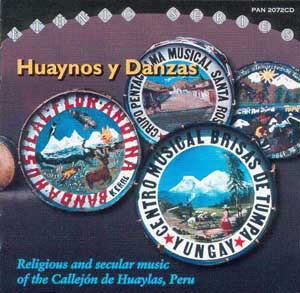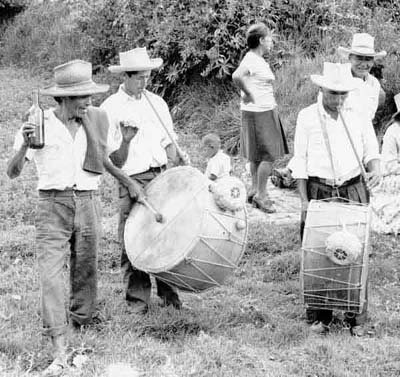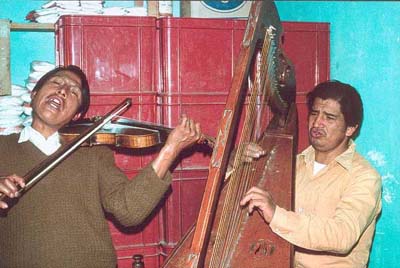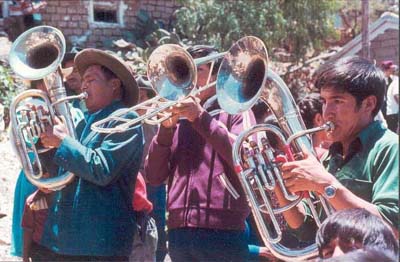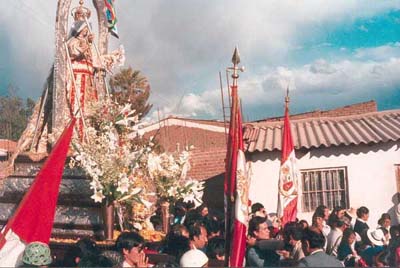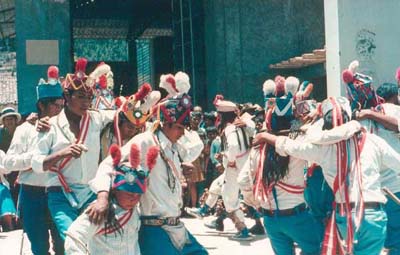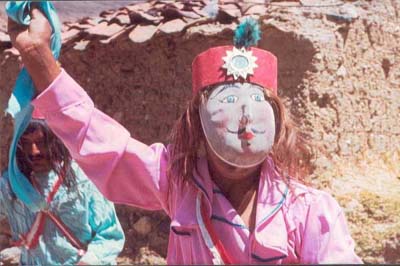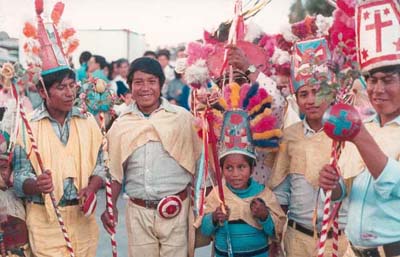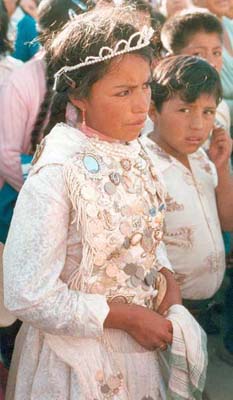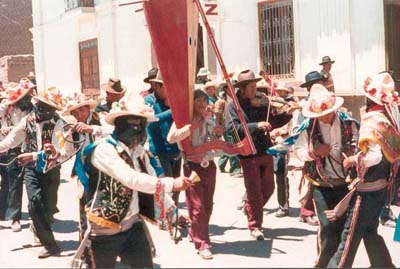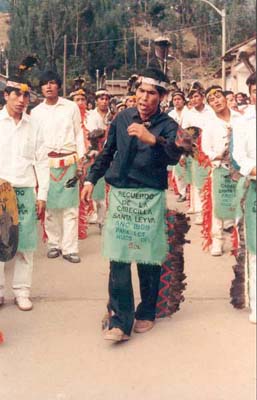Music of the Callejon de Huaylas, Peru
by Elisabeth den Otter
The Callejón de Huaylas is a 150 km. long valley in the Department of Ancash, in the north-central Peruvian highlands, 400 km. north of Lima. It is bordered by two mountain ranges, the Cordillera Negra (Black Range) to the West and the Cordillera Blanca (White Range) to the East. As the name indicates, there is no snow on the peaks of the Black Range; the glaciers of the White Range, like the Huascarán, reach over 6,000 meters above sea level. In 1970, an earthquake loosened a piece of this glacier, causing a mud avalanche which destroyed a number of villages. The Santa river runs all along the valley, into the Pacific Ocean near Chimbote.
The population of the Callejón consists of Quechua-speaking indians, mostly peasants who live in the mountain villages, and Spanish-speaking Mestizos (people of mixed indian and Spanish origin) who live in the small towns along the Santa river. The Mestizos dominate the indians, economically and politically, but changes in the life of the indians are brought about by (temporal) migration, education, military service and tourism.
The beauty of the valley, the horror of the earthquake, and the difficult everyday life of the inhabitants are the subjects of many songs.The recordings were made in 1980-1981, during an 18 month stay in the valley. A CD: 'Huaynos y Danzas. Religious and secular music of the Callejón de Huaylas, Peru' was published in 1999 by PAN Records, The Netherlands.
Secular music
Secular forms of music and dance in the Callejón de Huaylas are the huayno, the marinera and the waltz.
The huayno is typical of highland Peru, and the most popular type of music, song and dance in the Callejón. It is played in secular settings: in the homes at birthdays, baptisms and weddings, and in the streets during Carnival and national holidays. It is a pair dance, accompanied by many different types of ensembles, from flute and drum to brass band. When it is played on a solo instrument like the harp, the harpist often sings to his own accompaniment. String orchestras often have a male or female vocalist. The public participates by clapping their hands, beating the rhythm on the sound box of the harp, whistling or singing along, and dancing. Huaynos generally consist of two or three stanzas followed by a faster refrain (fuga). They show a mixture of pre-Columbian and Spanish traits: they are often pentatonic, with syncopated indian rhythms. The stanzas are usually in Spanish, but many fugas are sung in Quechua. The marinera and the waltz are of European origin and are mostly danced in Lima and other coastal towns. In the highlands these dances exist in a somewhat rougher version. The waltz more like a slow foxtrot than the whirling Viennese waltz known to Europeans. The marinera in 6/8 time is an intricate and elegant courtship dance; it was named after the valiant Peruvian marine who fought against Chile from 1879-1883. It used to be the national dance of Peru, but due to migration from the highlands to the coast, the huayno is replacing the marinera.
Two musicians play the huayno 'Rio Santa' on large double skinned drums & three holed plug flutes (cajas & roncadoras) during Carnival in Acobamba. The river Santa that runs through the valley is a source of life to the farmers and the subject of one of the best known huaynos of the area. Freely translated, the song says: "River Santa, take my sorrows with you. Everyone tells me that you are holy, but to what avail, if your currents are treacherous." The musicians play both instruments simultaneously, holding the flute in their right hand and playing the drum with their left hand, hitting the skin and the rim in alternation with a beater.
Harp and violin duo play the huayno 'Tomando cerveza' during the patron saint festival of Mancos (Saint Rochus). These musicians perform in a small bar during a patron saint festival. Sounds of the procession (rockets) are heard in the background. The harpist sings the huayno, as follows:
Tomando cerveza yo me emborraché
(I got drunk drinking beer)
Medio borrachito te entregué mi amor
(Half drunk I gave my love to you)
A la media noche voy a regresar
(At midnight I will come back)
De tu mamacita te voy a robar
(I will take you away from your mother)[Etc.]
European brass bands were introduced around the turn of the century and have become very popular. They include wind instruments like the clarinet, the trombone, the tuba, the trumpet, and the saxophone; drums like the bass drum and the snare drum; and percussion instruments like the cymbals. Brass bands perform during secular as well as religious events; they accompany the patron saint during the procession, with religious music, and play huaynos and other secular music at the home of the sponsors afterwards. The average number of musicians in these bands is fourteen.
Brass band 'Banda Orquesta Hijos de Shupluy' (Band Orchestra Sons of Shupluy) plays the
Huayno-cumbia: 'Hoy estoy aqui', during Carnival in Yungay. This mix of huayno and cumbia is called chicha or Peruvian cumbia; a gourd scraper (guiro), typical of the so-called tropical music, is added to the band for this purpose. The text is as follows: "Today I am here, but not tomorrow. The day after tomorrow, where will I be?"
Religious music
Religious music is played mostly during processions, at the occasion of patron saint festivals, Holy Week and Corpus Christi. Flute and drum ensembles and brass bands play special music, and traditional dance groups are accompanied by flutes and drums, harps and violins, or brass band instruments such as clarinets. During patron saint festivals, secular music - mostly huaynos - is played in the homes of the sponsors or in small bars.
Traditional dance groups
The traditional dance groups enact the main eras in the history of the Callejón de Huaylas: groups like the Ñustas are a reminder of pre-Columbian times; groups like the belligerent Shaqshas represent battles fought against the Spaniards during the Conquest; and groups like the Negritos refer to colonial times. The fact that the Spaniards are not represented in many of the dance groups may indicate a wish to return to pre-Columbian times and forget about the time after the Conquest. The Atahuallpas re enact the murder of the last Inca, thereby preserving the memory of the Conquest. They are a relatively recent phenomenon in the area, and their dress (North-American indian style, probably copied from cowboy-and-indian movies) and dance style are different from that of the more established traditional groups. By re-creating the past in this way, the cultural identity of these groups is safeguarded and transmitted.
During the patron saint festival of Carhuaz, Our Lady of Mercy, many of these groups come down from their hamlets in the mountains to honour their Virgin.
The Shaqshas are a group of men, one or two of them young boys, who dance to the music of two violins, two six holed reed plug flutes (chiskas) and a small double skinned drum (tinya). Pieces of cloth with dried fruit shells (shaqapas) are tied around their lower legs, which rattle when they stamp their feet or shake their legs.
The leaders wear masks that represent Spaniards: they are made of metal mesh, which show a pink face with blue eyes and a black moustache and/or beard. They dance in two rows, weave figures or dance in a circle; also, they perform vigorous exercises, jumping around and over each other. In church and during the procession religious music is played, but afterwards secular huaynos are played, whereby the dancers invite female onlookers to dance with them.
The Antihuanquillas carry rhythm sticks with metal pellet bells, ribbons and paper flowers in top, in one hand, and in the other hand a small metal shield which they clash against the rhythm stick to underline the dance steps. They wear pieces of cloth with dried fruit shells around their lower legs. They are accompanied by musicians playing processional music on two violins and a harp playing the bass accompaniment. Brass bands and rockets can be heard in the background.
The Ñustas represent married women of royal blood were called Pallas and unmarried princesses Ñustas, during the reign of the Incas. They are represented in the only type of traditional dance group in the Callejón de Huaylas in which women participate. They carry rhythm sticks with metal pellet bells, ribbons and paper flowers in top. A man called Rumi Ñawi, after Inca Atahuallpa's commander in chief, accompanies them. In church and during the procession they sing religious songs accompanied by a harp, two violins, a muted trumpet and two saxophones. (Their soft voices are hardly audible.) The muted trumpet and the saxophones (alto and tenor) are originally brass band instruments and were adopted by this traditional orchestra.
The Negritos carry a small whip with a small metal handbell attached to one end, which they shake to the rhythm of the music. They are accompanied by two violins, a harp, a clarinet and a muted trumpet. The clarinet and the muted trumpet are originally brass band instruments.
The name of this group, Little Negroes, may be a reference to the African slaves that were brought to Peru to work on the sugar plantations.The Atahuallpas are named after the last Inca Atahuallpa, who was betrayed and murdered by Pizarro. They are accompanied by three violins, two small double skinned tenor drums (tambores), and a small double skinned drum (tinya). This group, called 'Hijos del Sol' (Sons of the Sun), is dressed like North-American indians. The leader carries a metal shield and lance, with which he indicates changes in movement by clashing them together. The music, songs and dances of the Atahuallpas are quite different from those generally observed in the Callejón de Huaylas. They are a relatively new phenomenon in the area, maybe due to the fact that people from Carhuaz that work in the coastal town of Paramonga saw cowboy-and-indians movies and started to perform this type of musical drama as an imitation and from a sense of pan-Amerindianism.
The forms of music and dance that are performed during different events, be they religious or secular, may be seen as forms of 'total theatre', in which expressive forms like music, song (texts), (masked) dance, and costumes are combined.
